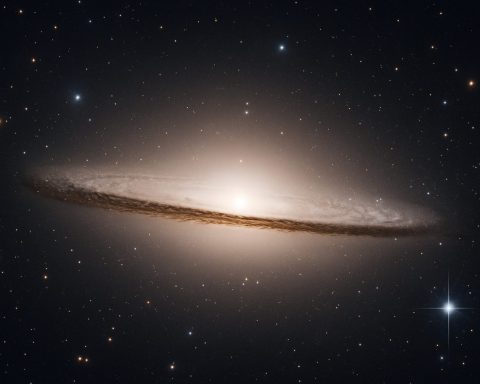- Pulsar PSR B1509-58 (B1509) emits powerful X-ray streams, visible in NASA’s Chandra X-ray Observatory images.
- Pulsars, like B1509, are remnants of massive stars, characterized by their rhythmic pulsing of energy, and discovered by Jocelyn Bell Burnell in 1967.
- B1509, notable for its magnetic power and rapid rotation, generates charged particle winds, creating stunning space patterns.
- Jocelyn Bell Burnell’s discovery of pulsars has significantly advanced astrophysics, enhancing our understanding of neutron stars, gravity, and quantum dynamics.
- B1509 and other pulsars serve as crucial astronomical beacons, offering insights into the universe’s architecture and mysteries.
- Pulsars symbolize scientific curiosity, with each rotation revealing glimpses into the universe’s majestic order and chaos.
Amid the swirling chaos of the cosmos, a celestial dynamo spins ferociously, painting the universe with radiant X-ray streams. Nestled at the heart of a spectacular image from NASA’s Chandra X-ray Observatory lies the young and potent pulsar PSR B1509-58, affectionately known as B1509. This cosmic lighthouse, a relic of a massive star’s explosive death, emanates waves of energy that dance vividly across the galaxy.
The saga of pulsars began thanks to the keen perception of Jocelyn Bell Burnell in 1967. With the hum of radio signals whispering stories from distant dying stars, she uncovered a new chapter in astronomical discovery. Pulsars, the stellar remnants characterized by their rhythmic pulsing of radio waves, have since become crucial astronomical beacons, offering insights into the mysteries of neutron stars and the limits of matter.
B1509, with its magnetic prowess, stands distinct. Its torrential rotations—faster than a kitchen blender—produce winds of charged particles that form stunning patterns in space. The pulsar’s X-rays reveal an aftermath of formidable power, with streams illuminating nebular clouds as they swirl in an ethereal dance.
Jocelyn Bell Burnell’s discovery paved the way for today’s astronomers. Her contributions have accelerated the field of astrophysics, allowing scientists to pry deeper into questions concerning gravity and quantum dynamics. The legacy of B1509 and its cosmic kin have opened new vistas in understanding our universe’s architecture.
In the symphony of stars, pulsars are the relentless metronomes, ticking and tocking through the cosmic orchestra. They are not just remnants of stellar deaths but also heralds of astronomical revelations. As we continue to probe the vastness of space, these pulsars provide a steady beat, a cosmic heartbeat, guiding researchers deeper into the universe’s enigmatic mazes.
The pulsar phenomenon embodies the spirit of inquiry and the boundless curiosity that fuels scientific endeavor. Each rotation of B1509 offers a glimpse into the majestic—and sometimes chaotic—order of the universe, reminding us that the stars are ever closer, with stories waiting to be told.
Unveiling the Mysteries of the Cosmos: The Intriguing World of Pulsar PSR B1509-58
Introduction
In the vast expanse of the universe, pulsars like PSR B1509-58 (B1509) serve as both cosmic lighthouses and complex puzzles, offering crucial insights into the dynamics of stellar evolution and the laws of physics. This article delves deeper into the significance of B1509, exploring its unique characteristics, contributions to astrophysics, and the technological advancements that allow us to study such celestial wonders.
What Sets B1509 Apart?
PSR B1509-58 is a young pulsar located approximately 17,000 light-years away in the constellation Circinus. Its rapid rotation—spinning about seven times per second—and extremely strong magnetic field make it an extraordinary subject for study. The pulsar’s intense magnetic field is likely a trillion times stronger than Earth’s magnetic field, causing it to emit powerful waves of X-rays and other radiation.
How-To Steps for Observing Pulsars
1. Select Your Observatory Tools:
– Use high-resolution telescopes like NASA’s Chandra X-ray Observatory.
– Consider radio telescopes such as the Very Large Array (VLA) for complementary data.
2. Focus on Emission Patterns:
– Track the pulsar’s timing and rotational behavior.
– Analyze X-ray and radio wave emissions to map its magnetic field.
3. Data Analysis:
– Compile and process data using software designed for pulsar analysis.
– Compare your results with existing models to uncover new insights.
Real-World Use Cases
The study of pulsars like B1509 is pivotal in understanding neutron stars’ extreme conditions. This research can lead to breakthroughs in:
– Nuclear Physics: Providing insights into matter under densities and pressures unattainable in laboratories on Earth.
– Gravitational Physics: Offering opportunities to test the accuracy of Einstein’s general relativity.
– Astrophysics: Enhancing our understanding of the lifecycle of stars and the formation of black holes.
Market Forecasts & Industry Trends
The field of astrophysics is witnessing significant advancements in telescope technology and data analysis techniques. The increasing number of space missions focused on high-energy astrophysics is expected to further the study of pulsars, driving interest in careers within astronomical research and associated technology sectors.
Reviews & Comparisons
Advantages of X-ray Observatories:
– Allow for precise tracking of pulsars and their emissions.
– Provide detailed insights into the structure and behavior of pulsars.
Limitations:
– Depend on clear space conditions and can be impeded by cosmic dust and interference.
– Require significant computational resources for data analysis.
Expert Insights & Predictions
Astrophysicists predict that ongoing and future explorations of pulsars like B1509 will likely yield new discoveries in dark matter research and quantum mechanics. The continuous improvement in technology enhances our capability to observe these celestial phenomena.
Actionable Recommendations
– Educate Yourself: Delve into resources and publications about neutron stars and pulsars to build foundational knowledge.
– Engage with Astronomical Societies: Join discussions and workshops to stay informed about the latest research.
– Support Space Exploration Initiatives: Advocate for continued investment in astronomical technology and missions.
Conclusion
Pulsar PSR B1509-58 stands as a testament to the universe’s complexity and the human spirit of discovery. Their study helps unravel the mysteries of the cosmos while pushing the boundaries of science and technology.
For more on astrophysics and ongoing space missions, explore the latest at NASA and ESA.









